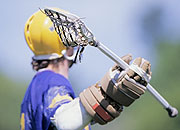
WEDNESDAY, Oct. 30 (HealthDay News) — A “culture of resistance” pervasive in many youth sports often keeps athletes from reporting concussions and obtaining needed treatment, a new U.S. report finds.
This culture persists despite a growing understanding that all concussions cause some degree of brain injury, according to the report released Wednesday by the Institute of Medicine (IOM).
“We know that concussions are frequent and potentially serious,” said IOM committee vice-chair Dr. Frederick Rivara, a professor of pediatrics at the University of Washington School of Medicine in Seattle.
Reviewing data on concussions suffered by 5- to 21-year-olds, the committee of independent experts found that reported concussion rates are higher among high school athletes than college players in sports such as football, men’s lacrosse, soccer and baseball. And despite marketing hype, the committee found that current helmet designs provide little protection from concussions.
Tracey Covassin, an assistant professor of kinesiology at Michigan State University in East Lansing, said concussions may go unreported for a variety of reasons.
“There are still coaches and parents that think kids need to tough it out and continue to play, or if they don’t tell anyone it will go away,” said Covassin, who helped prepare the report.
Young athletes may also not know they have a concussion or realize the consequences of playing with a concussion, she noted.
“They may also think they may lose playing time and their starting position,” Covassin said.
According to the report, concussions occur more often during games than in practice — except in cheerleading — and are most often suffered in football, ice hockey, lacrosse, wrestling, soccer and women’s basketball.
Rates are also higher for kids with a history of concussions and for female athletes.
Helmets aren’t worn in some sports where concussions are most likely to occur, Covassin noted. On the other hand, no scientific evidence was found to show that helmets could protect athletes from concussions, anyway.
Rivara explained: “While helmets are designed to prevent skull fractures and intracranial bleeding, and they are quite effective at that, there is limited scientific evidence that helmets can prevent concussion.”
Also, there is no evidence that products such as mouthguards and headbands for soccer protect players from concussion, Rivara said.
Typically, kids recover from a concussion within two weeks, but in 10 to 20 percent of cases concussion symptoms last for weeks, months or even years after the injury, the researchers found.
Dr. Robert Glatter, an emergency physician at Lenox Hill Hospital in New York City, said the long-term consequences of concussions, particularly multiple concussions, can include memory changes and mental problems, such as difficulty concentrating.
“We need to break through this ‘culture of resistance'” that encourages injured athletes to continue playing, Glatter said. “After a concussion, children need mental rest as well as physical rest. The most important thing is to keep a child out of school to insure a period of rest and allow the child to heal.”
Athletes who play before their brain has healed may place themselves at risk for more serious consequences if they have a second brain injury, Glatter said.
Such consequences might include depression, the committee found after reviewing surveys of retired professional athletes.
The report authors said much more information is needed on the incidence of concussion and related harms. They urge the Centers for Disease Control and Prevention to start collecting data on concussions suffered by young athletes and categorize it by sport, gender and age.
In addition, “there need to be long-term studies about what happens after children have concussions at young ages,” Rivara said.
The report also calls for a study of rules and regulations in sports to see how they might affect the risk of concussions.
“Finally, there need to be educational programs to change this culture of resistance,” Rivara said.
In the United States, the number of people 19 and under treated in emergency rooms for concussions and other traumatic brain injuries linked to sports and recreational activities jumped from 150,000 in 2001 to 250,000 in 2009.
The IOM provides objective, evidence-based advice to policymakers and the public.
More information
For more information on concussions, visit the U.S. National Library of Medicine.
Copyright © 2025 HealthDay. All rights reserved.

